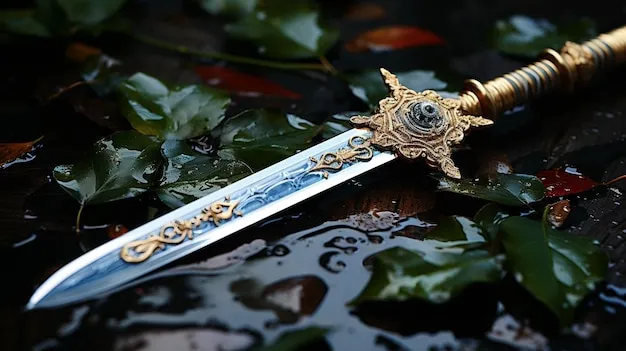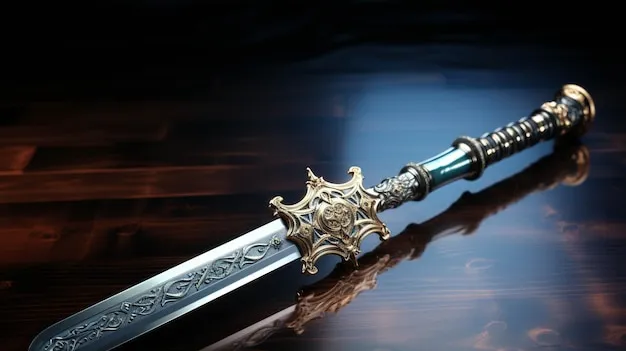Honangen Sword The Legendary Weapon of Japanese Craftsmanship

In the rich and storied history of Japanese weaponry,It stands out as one of the finest examples of craftsmanship, culture, and tradition. Rooted in the heritage of the samurai and ancient martial arts, the Honangen sword not only embodies the martial spirit but also represents an artistic endeavor. The distinctiveness of this sword comes from its impeccable forging techniques, balance, and symbolism.
If you’re fascinated by the world of ancient swords, Japanese tradition, or simply intrigued by the unique aspects of the Honangen, this comprehensive guide will give you everything you need to know—from its history and craftsmanship to its modern-day significance.
What is the Honangen Sword?
It is a type of katana, a traditional Japanese curved, single-edged sword that dates back to the feudal period of Japan. The term “Honangen” refers to a high-quality, custom-crafted sword typically made by renowned swordsmiths using the most refined techniques of their time. Honan gen swords are recognized not only for their practicality in battle but also for their beauty, balance, and the meticulous attention to detail in their creation.
Unlike mass-produced swords, each Honangen sword is a unique work of art, often passed down through generations as heirlooms. The finest examples of these swords were known to be made for elite samurai, warlords, and sometimes even emperors, signifying both their power and prestige.
Historical Background of the Honangen Sword
The Honangen traces its origins to the Muromachi Period (1336-1573), a time when samurai culture was flourishing in Japan. During this era, sword-making had reached a pinnacle, with swordsmiths perfecting techniques that would become iconic in Japanese culture.
At the heart of this tradition was the Tamahagane steel—a high-quality, pure steel produced from iron sand using a specialized smelting process. The creation of the Honangen began with Tamahagane, which was folded and hammered numerous times to create layers. This folding process not only eliminated impurities but also made the blade incredibly strong and flexible.
It became a symbol of status and martial prowess, often used by daimyos (feudal lords) and the most skilled samurai. These swords were treasured possessions, with their production often taking months of painstaking work, passed down through sword-making dynasties.
The Art of Swordsmithing: How a Honan gen Sword is Made
It is a detailed and labor-intensive process, requiring a deep understanding of metallurgy, physics, and artistry. Below is a breakdown of the stages involved in forging this legendary weapon:
The Selection of Materials
The core material of any authentic Honangen sword is Tamahagane steel, derived from iron sand (called satetsu) and refined in a traditional Tatara furnace. This steel is famous for its purity and the ability to be repeatedly folded, allowing the sword to acquire both flexibility and strength.
Additionally, some swordsmiths incorporate other types of steel—hard (for sharpness) and soft (for shock absorption)—creating a composite blade. This gives the sword its signature hard edge (cutting ability) while retaining durability in combat.
Folding the Steel
Folding the steel is perhaps the most iconic aspect of Japanese sword-making. A lump of molten steel is heated and then hammered to remove impurities and air pockets. The metal is folded upon itself, often 15 to 20 times, to create tens of thousands of layers. Each fold helps to increase the blade’s strength while ensuring it remains flexible, a crucial factor in preventing the sword from breaking during combat.
Forging the Blade
Once the steel has been sufficiently folded, the process of forging the blade begins. The swordsmith shapes the steel into the characteristic curved blade of the katana, known for its single cutting edge. The curvature is formed through differential heating and quenching—the back of the blade cools slower than the edge, causing it to curve as it solidifies.
During this stage, the swordsmith also creates the hamon—a visual temper line that runs along the blade, formed by coating parts of the blade with clay before the heating process. This distinctive wavy pattern isn’t just for aesthetics; it also serves as an indication of the blade’s hard and soft areas.
Polishing and Sharpening
After the blade has been forged and cooled, it undergoes an extensive polishing process that can take as long as the forging itself. Master polishers use a variety of grinding stones to sharpen the blade and bring out the intricate grain patterns (called hada) created by the folding process. The polishing phase also enhances the beauty of the hamon line, making the sword’s functional and artistic qualities shine.

Crafting the Sword Fittings
The sword’s beauty doesn’t stop with the blade. The tsuka (handle), tsuba (guard), and saya (scabbard) are also meticulously crafted by artisans. These parts are often adorned with intricate designs and made from materials such as silk, leather, wood, and metal. The fittings serve both practical and decorative purposes, ensuring the sword is balanced and easy to wield.
The Symbolism and Spiritual Significance of the Honangen Sword
In Japanese culture, swords are more than just weapons—they are symbols of honor, justice, and the warrior’s soul. The Honangen, in particular, carries significant symbolic weight due to its craftsmanship, history, and association with high-ranking samurai.
The Samurai Spirit
For the samurai, their sword was not merely a tool of war but a representation of their very identity. A samurai’s sword was a physical extension of their soul and was treated with the utmost respect and reverence. Samurai believed that their swords carried spiritual energy, which connected them to their ancestors and the divine. As such, the Honangen sword became an object of deep spiritual importance.
The Bushido Code
It also played a central role in the Bushido code, the ethical code of the samurai. Bushido emphasized values such as loyalty, courage, compassion, and honor. The sword was seen as a reflection of these values, and samurai were expected to use it with righteousness and self-discipline. The very act of caring for the sword—cleaning, sharpening, and polishing—was considered a spiritual practice in itself.
The Sword as a Symbol of Power
Throughout history, It was often gifted to esteemed warriors or members of the nobility. Possessing such a sword was a symbol of power, status, and the favor of the ruling elite. Some Honangen were even inscribed with prayers or religious mantras, further imbuing them with a sense of divine protection.
The Honangen Sword in Modern Times
Although the era of the samurai has passed, It continues to hold great significance in modern Japan and among sword enthusiasts worldwide. Today, swordsmiths still follow traditional methods to craft these magnificent weapons, and collectors highly prize authentic Honangen for their historical value and craftsmanship.
Honan gen Swords as Collectors’ Items
Original Honangen are considered priceless works of art. As rare artifacts from Japan’s feudal past, they are often displayed in museums or held in private collections. Due to the sword’s connection with historical figures and its association with the samurai, Swords are sought after by collectors around the world. Prices for genuine Honangen can range from tens of thousands to hundreds of thousands of dollars.
Honangen Sword making in Modern Japan
Despite technological advancements, there are still a number of swordsmiths in Japan who dedicate their lives to the craft of swordmaking. Recognized as Living National Treasures in some cases, these artisans adhere to ancient methods passed down through generations. The Honangen, crafted with the same dedication and care as centuries ago, remains a testament to the enduring legacy of Japanese swordsmanship.
Honan gen Sword vs. Other Japanese Swords
It is often grouped with other types of Japanese swords, it is important to note the key distinctions that set it apart:
Katana: Although the Honangen shares similarities with the katana, it is distinguished by its exceptional quality, craftsmanship, and attention to detail. Swords are typically custom-made and are regarded as superior to mass-produced katanas.
Tachi: The tachi is another traditional Japanese sword that predates the katana. While both swords share a curved blade, the tachi is worn edge-down, whereas the katana is worn edge-up. It often combine the best aspects of both designs, with the elegance of a tachi and the cutting efficiency of a katana.
Wakizashi: The wakizashi is a shorter sword, often paired with a katana in a set known as daisho. While Honan gen swords are usually full-length katanas, the term can also apply to custom-crafted wakizashi swords.
Conclusion
The Honangen sword is more than just a weapon—it is a symbol of the artistry, spirituality, and discipline that define Japanese culture. Rooted in a centuries-old tradition, this sword embodies the highest ideals of craftsmanship, representing the pinnacle of sword-making.
Whether admired for its historical significance, its unparalleled craftsmanship, or its symbolic meaning, It remains a timeless artifact of Japan’s samurai past. In today’s world, it continues to captivate collectors, martial artists, and enthusiasts alike, serving as a reminder of the power and grace of traditional Japanese weaponry.
In the end, It is not just a piece of steel—it’s a piece of history, infused with the spirit of the samurai and the dedication of the master swordsmiths who crafted it.




